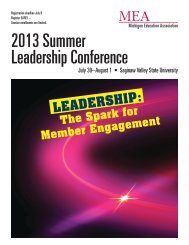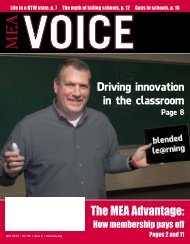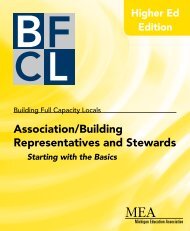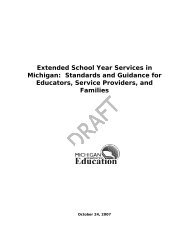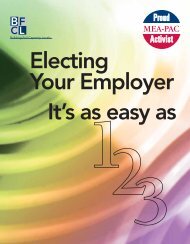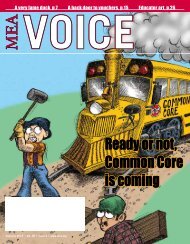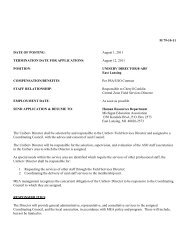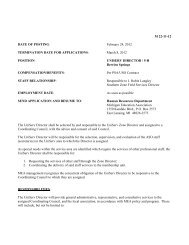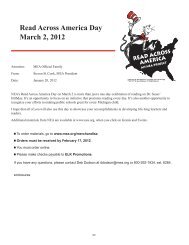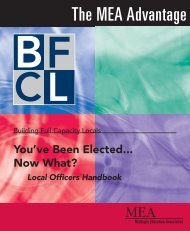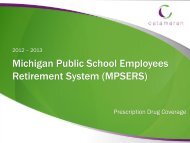2012 December - Michigan Education Association
2012 December - Michigan Education Association
2012 December - Michigan Education Association
Create successful ePaper yourself
Turn your PDF publications into a flip-book with our unique Google optimized e-Paper software.
Blast off!<br />
Kingsford science teacher<br />
ignites students’ imaginations<br />
The Discovery Channel’s “MythBusters” holds a special<br />
place in the heart for science lovers everywhere.<br />
Since 2003, hosts Jamie Hyneman and Adam Savage<br />
have thrilled audiences with hundreds of scientific experiments<br />
aimed at answering many of life’s persistent<br />
questions, such as: “How hard is it to find a needle in a<br />
haystack?” “Is yawning contagious?” “Are bulls really aggravated<br />
by the color red?” and “Can you eat a spoonful<br />
of cinnamon without drinking water?”<br />
The show is enough of a pop-culture icon to have<br />
inspired bobblehead dolls of Hyneman and Savage.<br />
Savage’s bobblehead features the bespectacled, goateed<br />
host strapped to a red-and-silver rocket.<br />
The bobblehead doll led chemistry and physics teacher<br />
Bill Bertoldi and his students at Kingsford High School<br />
to recently attempt to answer another nagging question:<br />
“How high will a 16-foot-long rocket fly with Adam<br />
Savage strapped to it?”<br />
A crew from Discovery’s sister network, the Science<br />
Channel, traveled to Penn Yan, N.Y., in July to witness<br />
the Tripoli Rocketry <strong>Association</strong>’s 31st Annual National<br />
Launch, where rocketeers from across the nation gathered<br />
to launch their unique creations.<br />
Among the rocketeers was Bertoldi, who coordinates<br />
Kingsford’s High Powered Rocketry Program. The<br />
program launched in the 1996-97 school year, as part<br />
of <strong>Michigan</strong> Technological University’s “Rockets for<br />
Schools” program.<br />
The program’s primary goal is to stimulate greater<br />
academic interest in science, math and technology by<br />
making it as exciting as possible. By building and testing<br />
rockets, students learn critical team-building skills,<br />
increase their knowledge and application of science, and<br />
get to meet professionals in the aerospace and engineering<br />
industries.<br />
“We see a lot of students who come who are not interested<br />
in going into fields like engineering,” Bertoldi says.<br />
“By the time they get done, they’re extremely interested.<br />
That’s very important.”<br />
The after-school program started with eight students<br />
and one rocket. Interest has grown over time, with the<br />
number of annual participants reaching 50 or more,<br />
meeting three times a week. The size of the rockets has<br />
also grown, from a single six-foot rocket kit in 1997, to<br />
17-foot-tall, computer-designed rockets today. Some<br />
rockets built by Bertoldi’s classes can nearly break the<br />
sound barrier.<br />
Bertoldi’s students design rockets with a computer program<br />
called RockSim. With it, they can tweak design elements<br />
to see how size, weight, nose cone configurations<br />
and the placement of fins can all affect rocket flight.<br />
They then apply skills similar to auto-body work in the<br />
actual construction of the rockets, using power tools and<br />
plenty of paint.<br />
After that comes some good old-fashioned engineering<br />
by way of trial-and-error. One example: the Team America<br />
Kingsford High<br />
School science<br />
teacher Bill Bartoldi<br />
and members of<br />
Kingsford’s High<br />
Powered Rocketry<br />
Program pose<br />
with some of their<br />
creations.<br />
MEA VOICE 17



